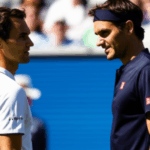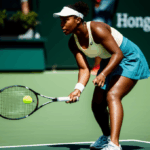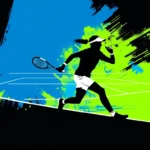For over two decades, Novak Djokovic, Rafael Nadal, and Roger Federer have dominated the world of tennis, forming the legendary “Big Three.” Their rivalries have captivated fans and pushed each other to achieve unprecedented levels of success. With Federer’s retirement and Nadal’s recent one, Djokovic remains the last active member of this iconic trio. Naturally, the tennis world is keen to understand his perspective on what set each of his great rivals apart. Let’s delve into how Djokovic himself identifies the key differences between Nadal and Federer, offering a unique insight into their contrasting styles and legacies.
Nadal: The Relentless Warrior
Djokovic has often spoken about the immense challenge that Nadal presents on the court. Nadal’s defining characteristic, according to Djokovic, is his relentless intensity and unwavering mental strength. Here’s what sets Nadal apart:
- Unmatched Intensity: Nadal approaches every point with incredible focus and determination. Djokovic has noted that playing against Nadal requires being at your absolute best consistently, as any dip in performance will be ruthlessly exploited.
- Physical and Mental Fortitude: Nadal’s strength, both physical and mental, is a significant factor in his success. Djokovic has acknowledged Nadal’s ability to maintain a high level of play throughout his career, overcoming injuries and setbacks with remarkable resilience.
- Clay Court Dominance: Nadal’s dominance on clay is unparalleled, earning him the title “King of Clay.” Djokovic himself admits that matches against Nadal on clay have been the most frustrating of his career. He recognizes the “highest mountain to climb” at Roland Garros because of Nadal, needing to beat him to claim the title.
- Aggressive Style: Nadal’s game is characterized by powerful groundstrokes and heavy topspin, particularly on his forehand. This aggressive style allows him to dictate play and put immense pressure on his opponents.
- Defensive Skills: Complementing his aggressive offense is Nadal’s incredible defense, making him exceptionally difficult to break down. His ability to retrieve seemingly impossible shots and turn defense into offense is a key component of his game.
- Constant Improvement: Djokovic has noted Nadal’s continuous evolution as a player, particularly his improved backhand. This adaptability and willingness to develop new aspects of his game have contributed to his longevity and sustained success.
Djokovic leads Nadal 30-29 in their head-to-head record, but the battles have been fierce and memorable, shaping both their careers.
Federer: The Elegant Maestro
In contrast to Nadal’s relentless power, Djokovic identifies Federer as the epitome of elegance and effortless brilliance on the court. Here’s what makes Federer unique:
- Effortless Style: Federer’s game is characterized by its fluidity and grace. His movements appear effortless, and his shot-making is often described as artistic.
- Serve and Forehand: Djokovic has stated that he would take Roger’s serve and forehand if he were to build the ultimate tennis player. Federer’s serve is precise and powerful, while his forehand is a weapon of both offense and defense.
- All-Court Prowess: Federer’s versatility allows him to excel on all court surfaces. His game is well-suited to both fast and slow conditions, making him a threat in any tournament.
- Ball Control: Nadal himself has acknowledged Federer’s exceptional ball control, describing him as “the best I ever played and I ever saw” in this aspect.
- Creating Opportunities: Nadal confessed that there were times when he couldn’t do anything against Federer, particularly in 2017 when Federer won all four of their matches.
- Low Slice/Back Return: Federer’s style of play includes his signature low slice/back return that causes problems for his opponent, allowing him to regain his position on the court.
Djokovic trails Federer 23-27 in their head-to-head record, a testament to the difficulty he faced against the Swiss maestro.
Head-to-Head Stats
The Big Three have contrasting head-to-head records against each other:
- Djokovic vs. Nadal: Djokovic leads 30-29. Of their 60 meetings, 27 were on hard courts (Djokovic leads 20-7), 29 on clay (Nadal leads 20-9), and 4 on grass (tied 2-2).
- Djokovic vs. Federer: Djokovic leads 27-23. They played 17 matches at the Majors with Djokovic leading 11-6.
- Nadal vs. Federer: Nadal leads 24-16.
The “Big Three” Legacy
The “Big Three” have redefined men’s tennis, setting new standards of excellence and longevity. Their accomplishments include:
- Grand Slam Titles: Djokovic leads with a record 24 titles, followed by Nadal with 22, and Federer with 20.
- Career Grand Slams: Each has completed a Career Grand Slam, winning all four major titles at least once. Djokovic has completed it three times.
- Weeks at No. 1: They have been ranked as world No. 1 for a combined 947 weeks: Djokovic (428), Federer (310), and Nadal (209).
- Masters Titles: Djokovic leads with a record 40 titles, followed by Nadal with 36, and Federer with 28.
Their dominance is further highlighted by the fact that one of the three finished the season as the year-end No. 1 player nearly every year from 2004 to 2023, with the exception of 2016 and 2022.
A Lasting Impact
Beyond the statistics, the “Big Three” have left an indelible mark on the sport of tennis. Their rivalries have inspired countless fans and players alike. They have demonstrated incredible sportsmanship and mutual respect, even amidst intense competition.
Djokovic himself has acknowledged the impact of Nadal and Federer on his career, stating that they “made each other better.” Their presence pushed him to constantly improve and strive for greatness.
In reflecting on his relationships with Nadal and Federer, Djokovic has admitted that they are “not friends” in the traditional sense, due to the competitive nature of their careers. However, he expresses hope that “one day, when the curtains are slightly more closed,” they will be able to “sit down and reflect” on their shared experiences.
Nadal also stated that Djokovic has earned the title of “the best” because “he’s been the most injury-free, which allowed him to maintain his physical, mental, and tennis levels longer than anyone.” Nadal also said, “I’ve played Djokovic more than anyone else, but for me, my biggest rival was Federer.”
End of an Era
With Federer’s retirement and Nadal’s recent one, the era of the “Big Three” is coming to an end. Djokovic remains a dominant force in the sport, but the absence of his two greatest rivals is palpable.
Djokovic admitted that it’s been “very difficult” for him to stay motivated after Nadal’s retirement. He expressed feeling like “a part of me has gone with him,” highlighting the profound impact that their rivalry had on his career.
The tennis world will forever remember the “Big Three” and their extraordinary contributions to the sport. Their contrasting styles, fierce rivalries, and unparalleled achievements have created a legacy that will endure for generations to come.








No Comment! Be the first one.